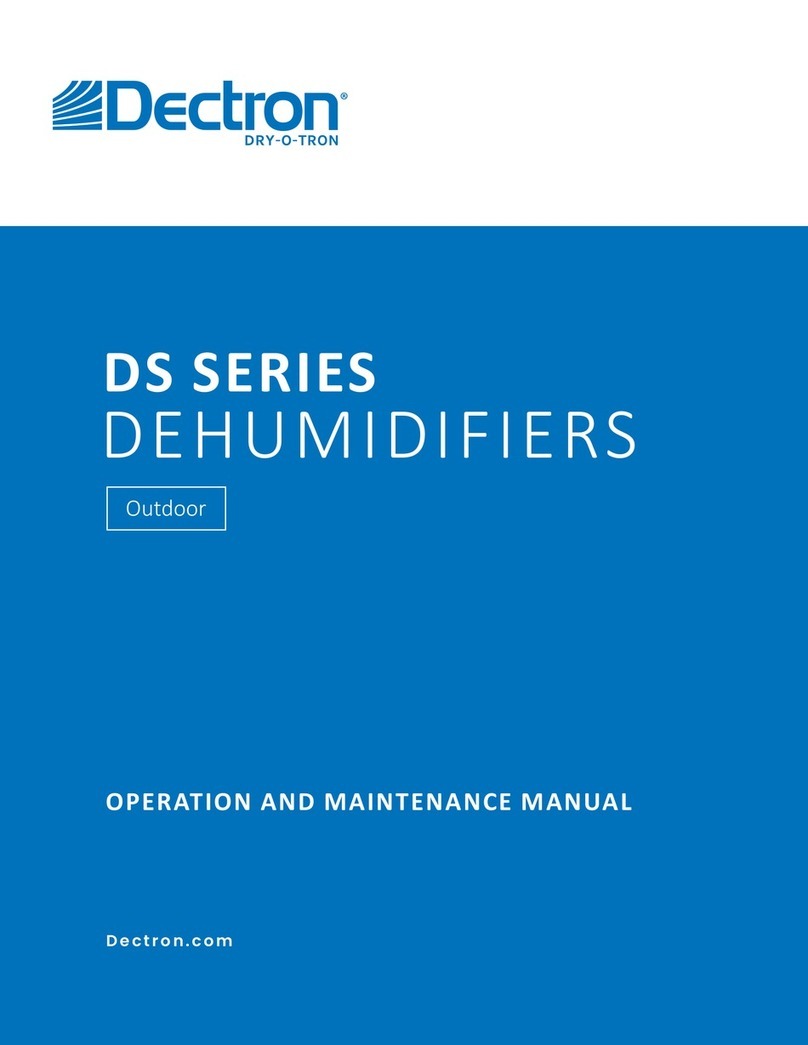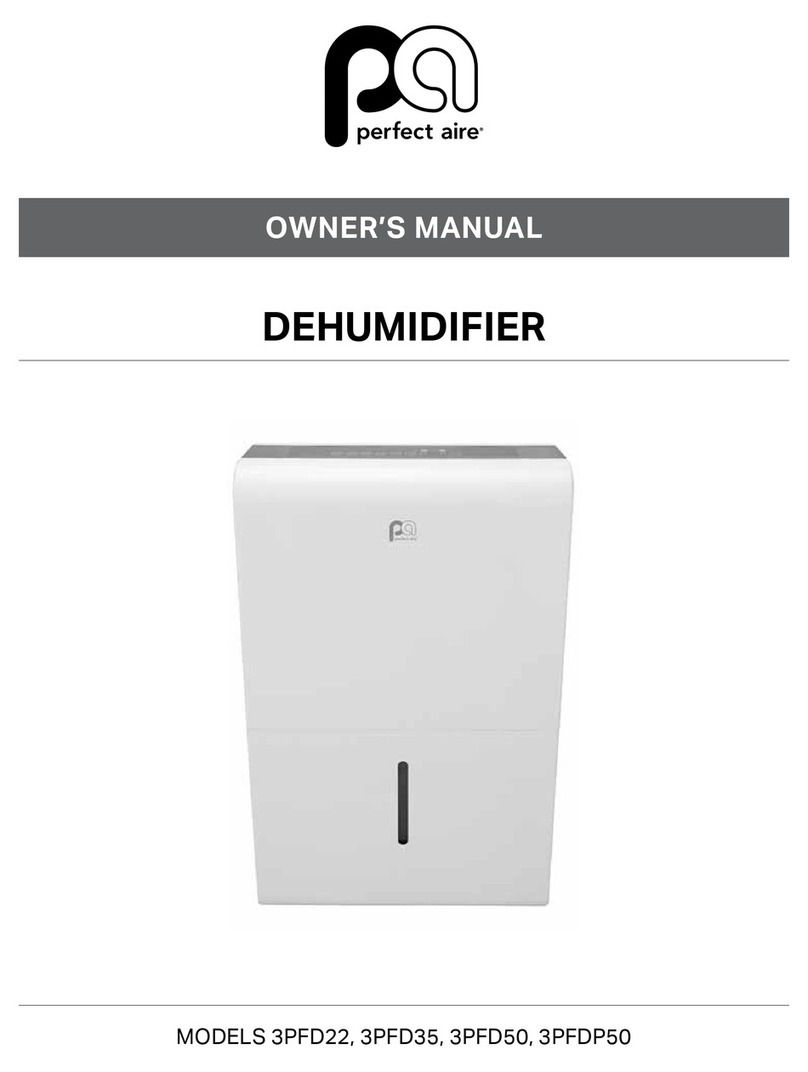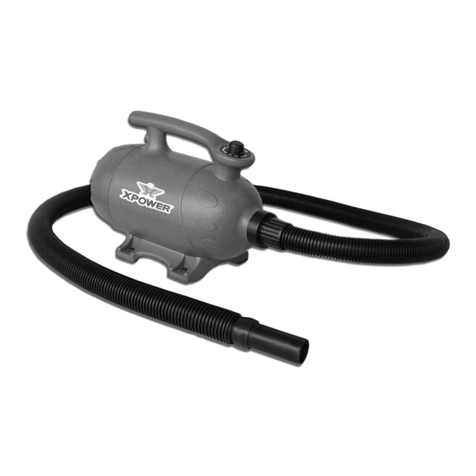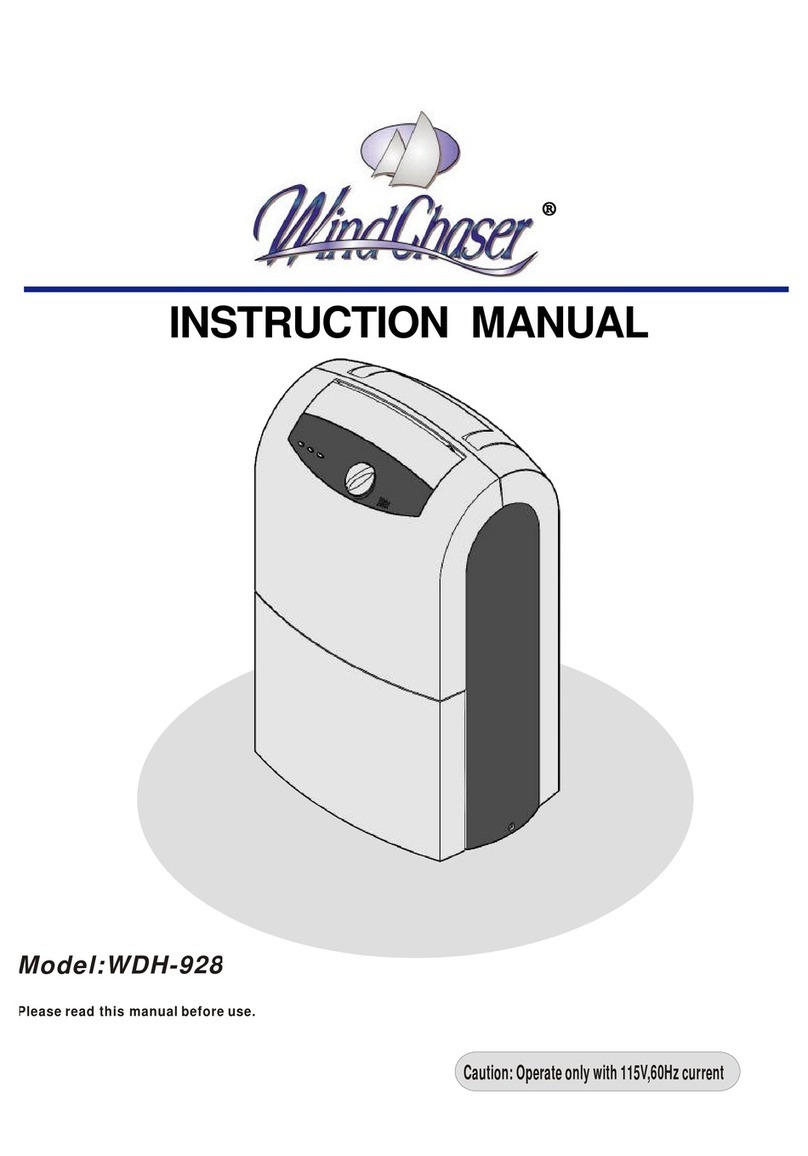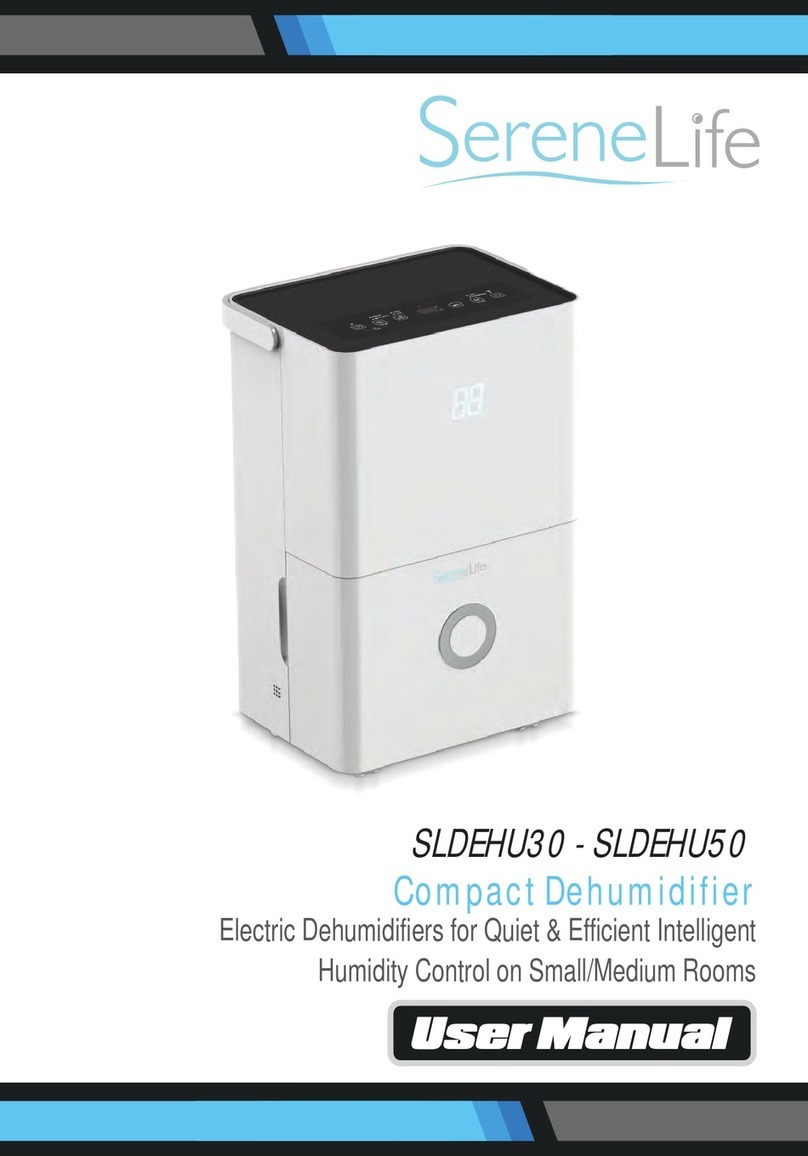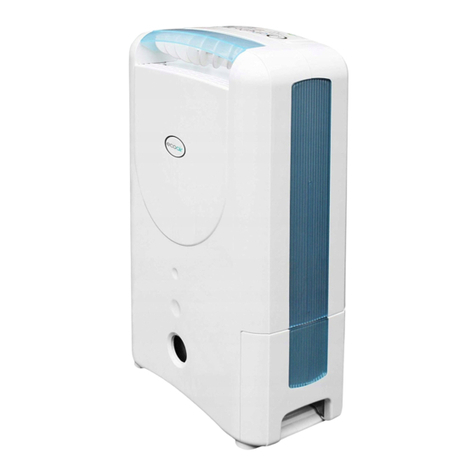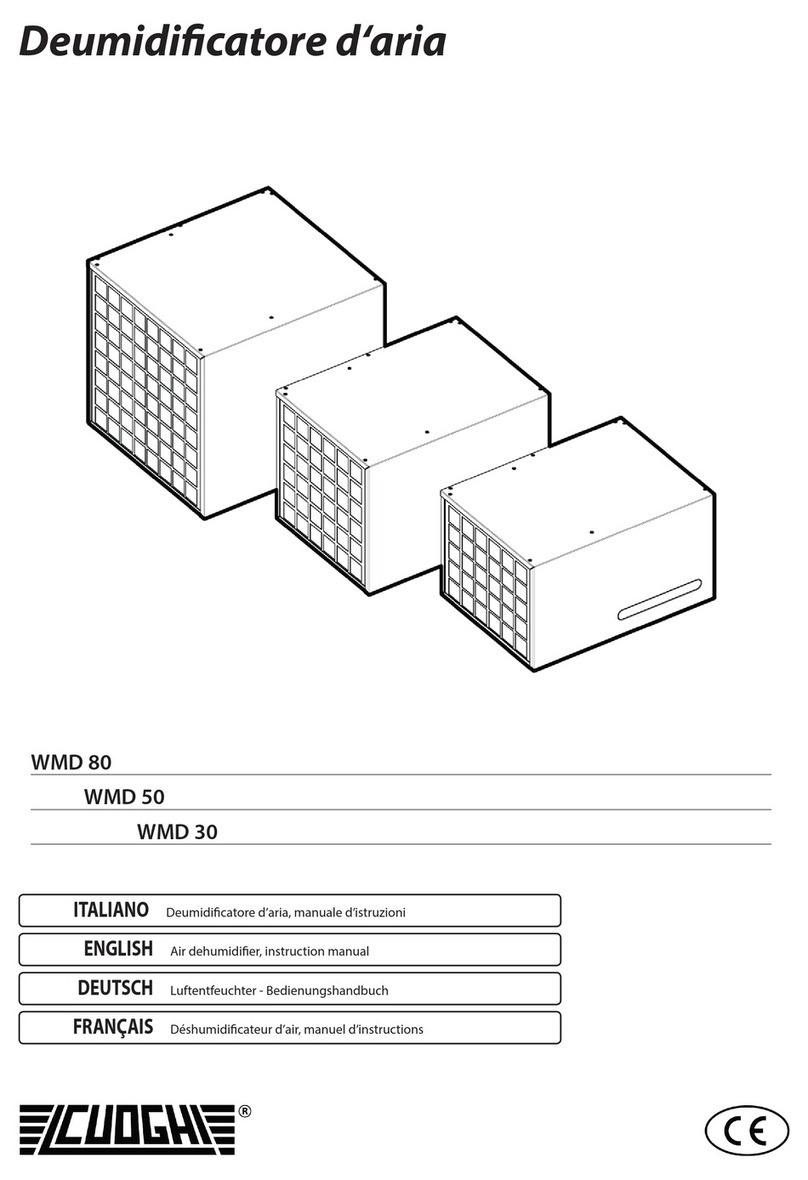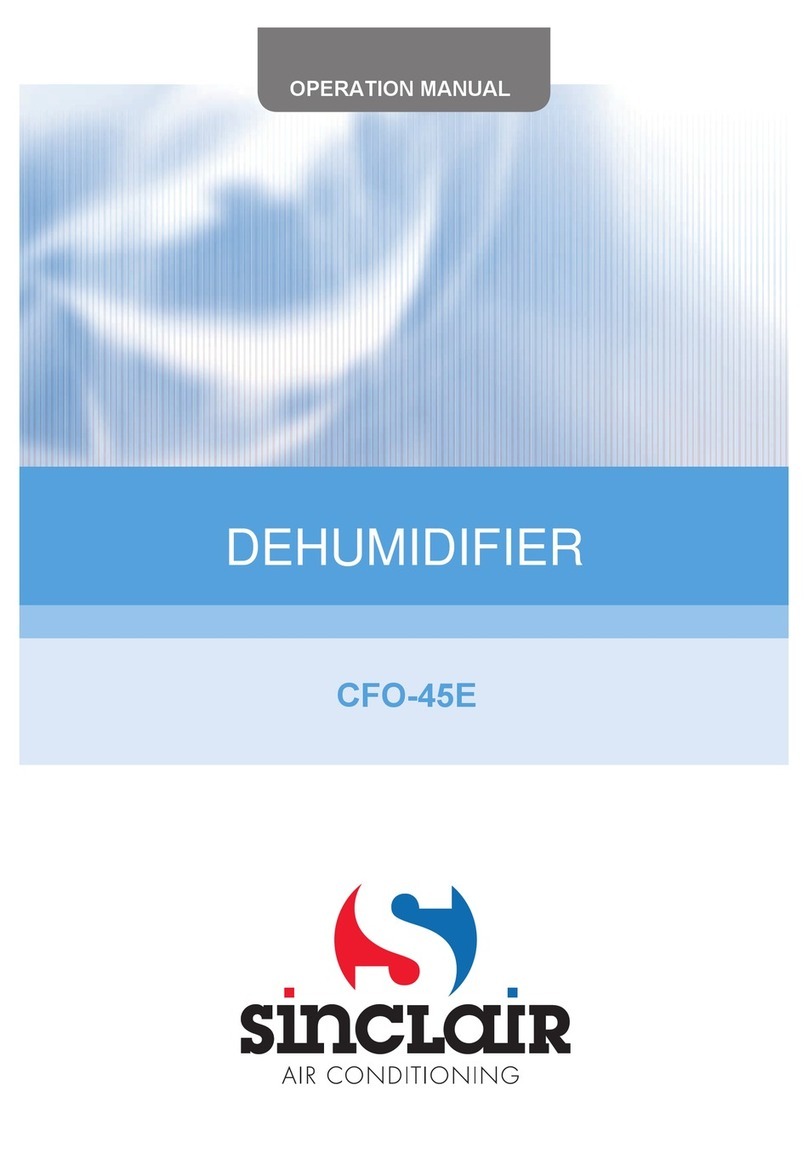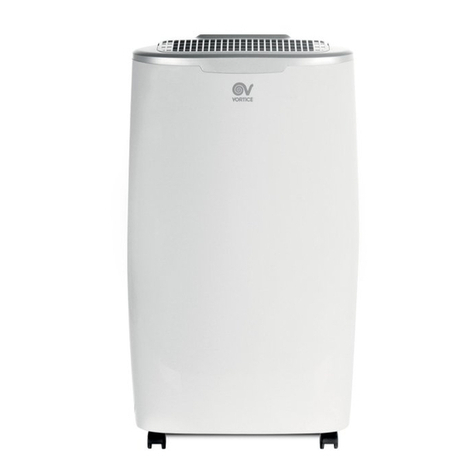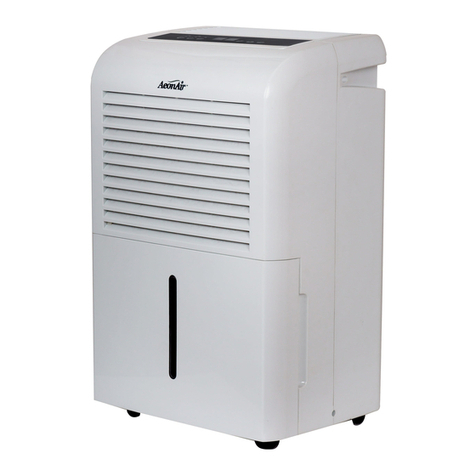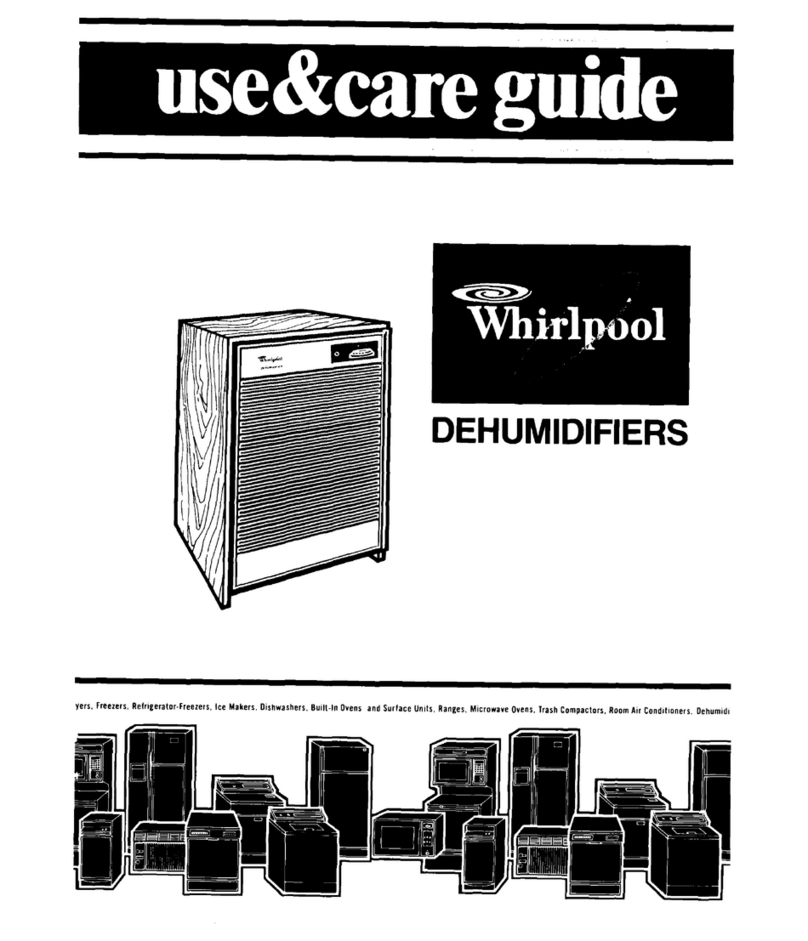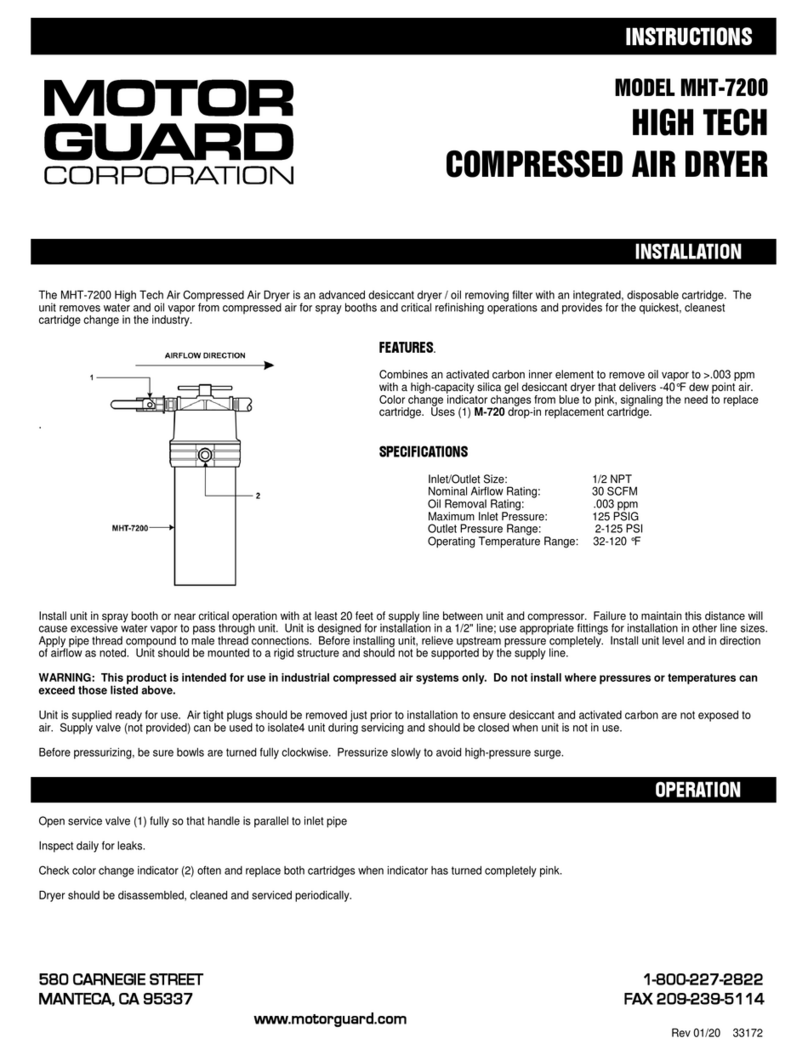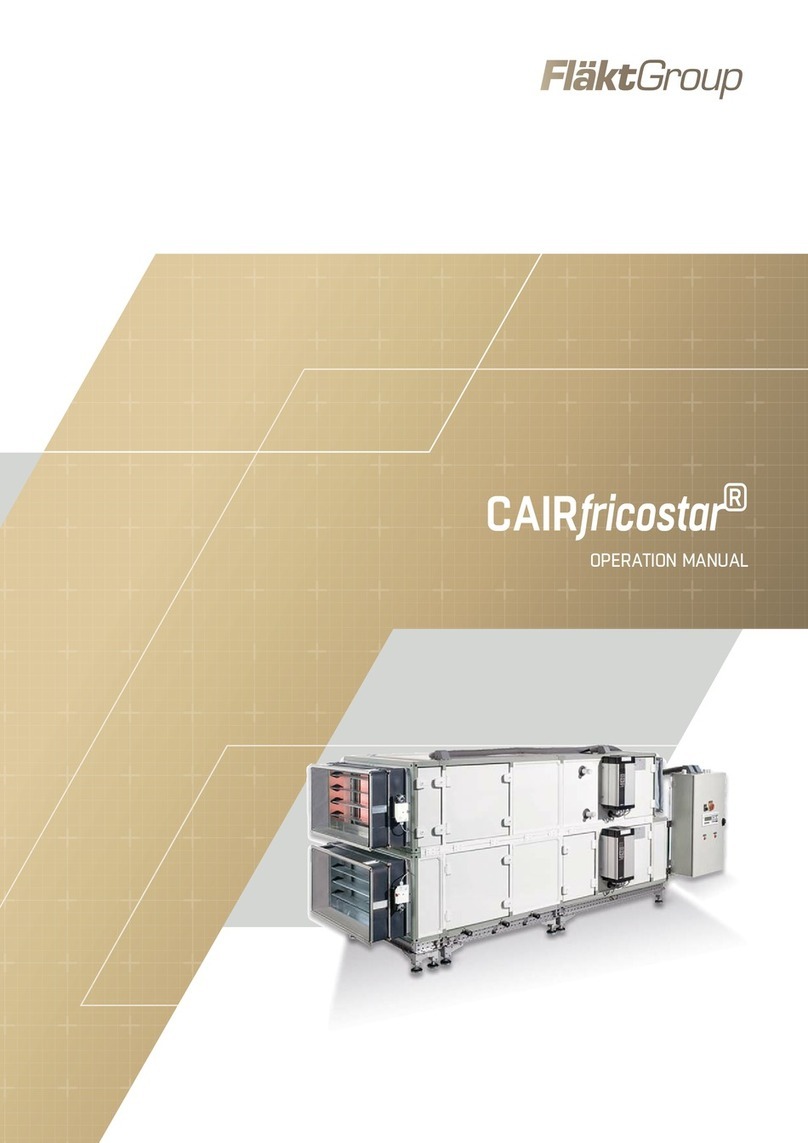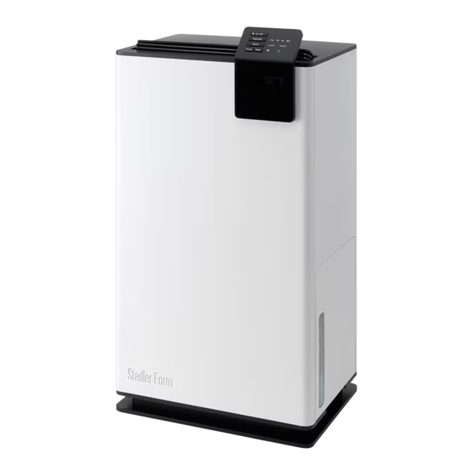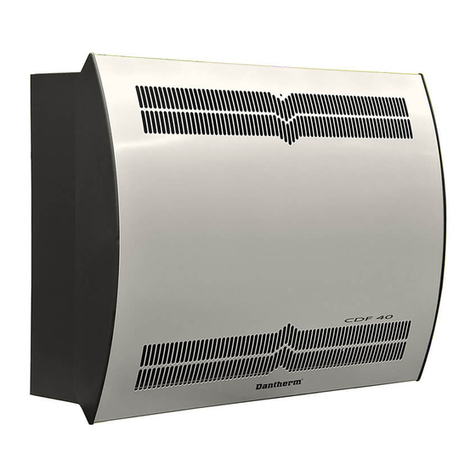Dectron LH Series User manual

DEHUMIDIFIERS
LH SERIES
Dectron.com
OPERATION AND MAINTENANCE MANUAL


Dectron LH Series OMM 2April 2022
Contents
General Information .....................................................................................................................................4
Operating Safety (Warnings, Cautions, and Notes)..................................................................................... 4
Reference and Additional Information........................................................................................................ 5
Contact Us.................................................................................................................................................... 5
Basic Information..........................................................................................................................................6
Dehumidifier View and Options................................................................................................................... 7
Dehumidifier External Systems Connection ................................................................................................ 8
Dehumidifier Optional Arrangement........................................................................................................... 9
Air Conditioning Options –Outdoor Air Fluid Coolers (OAFC).................................................................. 10
Equipment Specific Data............................................................................................................................ 12
Layout and Components.............................................................................................................................13
Dehumidifier Main Components ............................................................................................................... 13
Layout and Components (continued)........................................................................................................ 15
Control System............................................................................................................................................16
Outdoor Air Fluid Coolers Layout and Components...................................................................................17
Sequence of Operation ...............................................................................................................................18
Set Points.................................................................................................................................................... 18
Ventilation.................................................................................................................................................. 18
Cooling........................................................................................................................................................ 18
Cooling with Outside Air .....................................................................................................................18
Cooling with Evaporator coil...............................................................................................................18
Cooling with Chilled water coil ...........................................................................................................19
Dehumidification........................................................................................................................................ 19
Dehumidification with Outside Air .....................................................................................................19
Dehumidification with Evaporator coil ...............................................................................................19
Purge Mode................................................................................................................................................ 19
Heat Recovery............................................................................................................................................ 19
Space Heating............................................................................................................................................. 20
Compressor(s) If applicable. ...................................................................................................................... 21
Compressor Circuit Operation ................................................................................................................... 21
Outdoor Fluid Cooler Operation................................................................................................................ 22
Interface and Communication ....................................................................................................................23

April 2022 3Dectron LH Series OMM
Touch Display Operator Panel ................................................................................................................... 23
Alarms .................................................................................................................................................24
Remote Communication............................................................................................................................ 25
WebSentry...........................................................................................................................................25
BMS (Building Management System) ........................................................................................................ 25
Basic Maintenance......................................................................................................................................26
Maintenance and Safety ............................................................................................................................ 26
Maintenance Key Points ............................................................................................................................ 26
Routine Maintenance Program ................................................................................................................. 27
Specific Components Maintenance........................................................................................................... 28
Special Maintenance Tasks. Fluid Cooler Winterization. ........................................................................... 28
Pools –Equipment Warranty......................................................................................................................30

Dectron LH Series OMM 4April 2022
General Information
This manual provides basic information about the applicable Dectron dehumidifier and its operation.
Important information regarding installation, maintenance, and start up as well as additional and auxiliary systems
and devices (outdoor condenser, communication interfaces, etc.) is normally provided with the dehumidifier and
can also be obtained from the manufacturer (see Contact Us below).
Operating Safety (Warnings, Cautions, and Notes)
FOR YOUR SAFETY: READ BEFORE PERFORMING ANY OPERATIONS, MAINTENANCE OR SERVICE TASKS!
Only qualified technicians should install, operate, maintain or service mechanical equipment
including current dehumidification system.
Make sure to read this manual before performing any tasks to familiarize yourself with the
equipment as well as with any potential hazards. Always exercise caution!
Beware of electrical power and high electrical voltage!
•Follow proper safety procedures –lockout, tagout, and other respective procedures
•Failure to follow safety procedures can result in serious injury or death
Beware of moving parts and hot surfaces!
•Make sure to stop all moving parts (fans, blowers, etc.) before accessing the equipment’s
internal space
•Be aware of hot surfaces (hot refrigeration, space heating pipes, coils, heaters, etc.)
Beware of high pressures and chemicals!
•Dehumidifiers, equipped with compressors, contain refrigerant under high pressure; oil is
also contained in the compressor and refrigeration circuit(s)
•Some dehumidifiers may also contain other liquids such as glycol mixtures
The following warnings, cautions, and notes appear throughout this manual and referenced documentation
whenever special care must be taken to avoid potential hazards that could result in equipment malfunction or
damage, personal injury, or death.
WARNING
Indicates a potentially hazardous
situation which could result in
serious injury or death if handled
improperly.
CAUTION
Indicates a potentially hazardous
situation which could result in
moderate injury or equipment
damage if handled improperly.
Note
Indicates a situation that could
result in equipment damage or
improper/ineffective operation if
handled improperly.

April 2022 5Dectron LH Series OMM
Reference and Additional Information
For safe, efficient and problem-free operation, it is critical to handle the dehumidifier (as well as related systems
and components) properly at each step - from receiving and storage to installation and start up. Relevant
information can be found in the respective documents (like Installation Manual) provided with the dehumidifier.
This manual and other related documents could be obtained from the manufacturer (see Contact Us below).
Contact Us
Dectron
5685 Rue Cypihot,
Saint-Laurent, QC
H4S 1R3
Dectron.com
1-833-DAS-POOL (327-7665)
Schedule / Modify a Start-up:
Startups@DehumidifiedAirServices.com
Inquire about Warranty:
Warrant[email protected]
Order Parts:
Parts@DehumidifiedAirServices.com
All Other Product Support:
Start-up Requests: Start-ups@dehumidifiedairservices.com
Miscellaneous Inquiries: Support@dehumidifiedairservices.com
Parts Requests: Parts@dehumidifiedairservices.com
Warranty: Warranty@dehumidifiedairservices.com
Attention: Installation and Service Contractors
WARNING! Any work (installation, start up, service, maintenance, repair, etc.) on any mechanical
equipment (dehumidifier, outdoor condenser, fluid cooler, etc.) must be performed in accordance with
respective manufacturer’s recommendations as well as submittal documentation, local Codes and Regulations,
and appropriate field practices. Failure to do so could result in personal injury, equipment damage or
malfunction, and will void equipment warranty. Only qualified and properly trained individuals should perform
tasks on this equipment.
Attention: Maintenance Team
CAUTION. To ensure equipment longevity and proper and efficient operation, the dehumidifier and its
auxiliary systems and devices (outdoor condenser, fluid cooler, etc.) should be maintained properly and regularly.
Failure to do so could negatively affect natatorium comfort levels and people’s health. It could also lead to
equipment damage, malfunction, premature tear and ware and may void equipment warranty.

Dectron LH Series OMM 6April 2022
Basic Information
Pic. C.1

April 2022 7Dectron LH Series OMM
Dehumidifier View and Options
Standard NH series dehumidifiers are semi-custom: while basic concept and layout is the same, options and
specific systems and components layout and location may vary from one dehumidifier to another. One of the
typical dehumidifier arrangement is shown on Pic.C.1.
Dehumidifier Options
•Indoor or outdoor installation.
oNote: Pic. C.1. shows outdoor model, equipped with louvers (to protect air intake and discharge
openings from elements). Indoor model would have ducts connected to respective openings, no
louvers would be needed.
•Refrigeration Capacity (compressorless ’00’ model or cooling capacity in tons) –zero to three compressors
(see Dehumidifier Optional Arrangement below for more details):
oZero-compressor dehumidifier option (6,000 to 64,000 CFM Supply cabinet, models NH000).
oTwo-compressor dehumidifier option (18 to 80 tons, models NH018 to NH080).
oThree-compressor dehumidifier option (90 to 120 tons, models NH090 to NH120).
•Airflow/ductwork connection *. Pic. C.1 shows some options only; each option location availability depends on
the dehumidifier installation (indoor or outdoor) and other options:
oReturn Air (RA) ductwork connection - top, bottom, end, sides.
oSupply Air (SA) ductwork connection –top, bottom, sides.
oOA1ductwork connection/termination –top, sides.
oEA1 and optional EA2 ductwork connections/terminations –end, sides.
oOptional OA2 ductwork connection/termination - top, sides.
•Optional Space Heating - hot water coil, electric or gas heater **.
•Heat Recovery (HR) circuit.
•Air Conditioning (AC)* –compressorless can have a chilled water coil option; cooling refrigeration has external
water cooling or fluid cooler (packaged or separate) options.
oNote: Pic. C.1 shows outdoor model without a packaged fluid cooler.
o“Packaged’ AC option is available for outdoor models only; alternatively, indoor and outdoor models
could be fitted for separate/remote AC option –remote fluid cooler or other external cooling media
source.
* Some available options (tonnage, ductwork connections, AC options etc.) are shown. Refer to the submittal
and other relevant documentation for your dehumidifier’s options.
** For specific details on space heating (hot water, gas, electric) option, refer to the submittal and other
documentation:
Attention! Equipment Clearances and Dimensions!
CAUTION! For equipment proper operation, maintenance and service, respective clearances should be
maintained. Generally, 30” clearances to the equipment must be kept for the maintenance and service purposes.
For the specific required clearances information, as well as dehumidifier overall dimensions, distances to pipe
connections, duct connections etc., refer to the submittal documentation.

Dectron LH Series OMM 8April 2022
Dehumidifier External Systems Connection
Pic. C.1 shows provisions for external systems connections, including ductwork, electric power and various piping
connections.
✓Except for the condensate, all other piping systems are optional and may not be present in each
dehumidifier
•Condensate Drain Line –bottom, side (through the dehumidifier base).
•Air Conditioning (AC) Connection.
oChilled water coil option –bottom, side.
oPackaged AC option (outdoor dehumidifier with outdoor fluid cooler (OAFC) incorporated with the
dehumidifier), does not require piping connection to external AC system or device.
▪Packaged outdoor models typically have the OAFC mounted at the end of the dehumidifier;
alternatively, if requested, OAFC could be mounted on the roof of the dehumidifier.
oRemote (“split”) AC option (indoor or outdoor dehumidifier, connected to external cooled
water/glycol system or remote fluid cooler) –side or end (through the compressor compartment
wall) connection.
•Space heating (Hot Water connection) –bottom, side.
•Space Heating (Gas Heater connection, gas line).
•Electric Power and Control Connection. Typically the power lines are to be brought directly to the main
electric panel. However, if applicable the electric power could be brought to the dehumidifier disconnect,
which is normally incorporated with main electric panel.
WARNING! Gas Line. The gas line must be installed in accordance with respective device documentation
(boiler, furnace, etc.) and local codes and regulations.
CAUTION! Current manual shows general/default connections’ location. For details regarding specific
dehumidifier’s connections (actual location, piping sizes and position dimensions, circuit type and flow direction
etc.), refer to the dehumidifier’s submittal documentation as well as dehumidifier’s labels and stickers.
NOTE. Dehumidifier MUST be equipped with a P-trap at the condensate connection for proper operation! If
dehumidifier is requested from the factory without P-trap, one MUST be installed on site prior to dehumidifier
being commissioned. Refer to the Installation Manual for details.

April 2022 9Dectron LH Series OMM
Dehumidifier Optional Arrangement
Multi-Compressor Arrangement and Compressor Compartment Layout
NH series dehumidifier, depending on required capacity, could have two or three compressors. Pic.C.2 shows
options of dehumidifier supply air (SA) end and compressor compartment arrangement, based on number of
compressors and overall tonnage of the unit.
The end compressor compartment location is used for all tonnages in the NH series.
2
2
2
1
1
3
1
1
1
1

Dectron LH Series OMM 10 April 2022
Air Conditioning Options –Outdoor Air Fluid Coolers (OAFC).
Basic views of standard air conditioning options are shown on Pic.C.4 (below); standard combinations of the
dehumidifier and respective fluid cooler (based on their capacities) are shown in Table C.1. Note, that depending
on number of factors, dehumidifier may have different cooler provided with it - refer to the dehumidifier’s
submittal documentation for more details.
Standard fluid coolers used with this model of dehumidifier is NG-V series, composed of number of “two-coils-two-
fans” blocks, based on required capacity of the cooler:
•Fluid Cooler NG-V-22 (Fig.1) composed of two such blocks etc. The largest single fluid cooler, NG-V-62
(Fig.3) composed of six such blocks.
Pic. C.2
2
1
1
1

April 2022 11 Dectron LH Series OMM
Attention! Equipment Clearances!
Proper clearances should be maintained for adequate airflow and heat rejection! Generally, up to 36” side and
96” top clearances are required. For more information on clearances as well as equipment dimensions and other
details, refer to the submittal documentation.
Pic. C.4

Dectron LH Series OMM 12 April 2022
Equipment Specific Data
Specific information for individual dehumidifiers is provided in the following methods:
Main Label (Pic. C.5):the manufacturer tag attached
to the front of the dehumidifier includes the
dehumidifier’s most critical data:
✓General data including:
oSerial number
oDehumidifier model (nomenclature)
oDesign room conditions (air
temperature and humidity)
✓Operational data, including:
oRefrigeration (refrigerant type, charge,
etc.)
oElectrical/airflow (dehumidifier
voltage, CFM, etc.)
oOther applicable data (space/auxiliary
heating features, etc.)
Labels and Stickers: attached when applicable to
the exterior and interior of the dehumidifier to
show:
✓External systems connections location/direction
(pool/space heating, cooling circuits,
condensate)
✓Air filter locations, quantity, and size.
✓Additional Info (warning, caution stickers, etc.)
Wiring Diagrams: attached to the interior side of the
dehumidifier, depict dehumidifier control and power
wiring.
Remotely installed condenser or cooler would have its specific information provided in similar manner (labels etc.).
Attention! Glycol Circuits.
Unless otherwise indicated, equipment fluid circuits (except for refrigeration) such as heat recovery loop,
compressor glycol loop, fluid cooler etc., are normally filled/to be filled with water/glycol mixture; normally, rust
inhibitor-infused food-grade propylene glycol is used.
Glycol mixture concentration is normally shown on Main Label –refer as needed.
Note: The main label shown above is just an example.
Pic. C.5

April 2022 13 Dectron LH Series OMM
Layout and Components
The general layout and components location is the same for all dehumidifiers of current type, however some may
vary, based on the dehumidifier’s specific options –refer to submittal documentation. Pic. D.1 below shows most
available options, some of which may not be present on your dehumidifier.
Dehumidifier Main Components
•Main Blower(s) (1) is a supply fan array located at the supply air end of the unit.
Number of blowers may vary based on airflow requirements. Supply fans are
mounted within the fan boxes, in the fan wall (see pic D.1A for illustration).
Allowing built-in redundancy, a failed fan can temporarily be blanked off to allow
continued operation of the unit. Spare blank-off panel is also found in the supply
section of the unit.
•Main Electric Panel (2) is located at the supply air end of the unit. Either in the
compressor vestibule section, if the unit has compressors, or at the supply end of
the unit, outside of the airstream in their own dedicated vestibule.
•Outdoor Air (OA1) Opening (4) has a motorized damper, HR coil(s) and filter(s).
OA1 is also fitted with a modulating actuator for automatic adjustment of outdoor air intake.
oOutdoor-installed dehumidifier would have a louver(s) installed at the OA opening.
oIndoor-installed dehumidifier would have a Filter Box(s) installed at the OA opening.
•Exhaust Fan Blowers (5) also use fan array which is located on the dehumidifier’s return air side. Exhaust Air
opening in outdoor-installed dehumidifier is equipped with louver(s). Number of blowers may vary based on
Pic. D.1A
Pic. D.1
1
7
3
2
5
6
4
9
8

Dectron LH Series OMM 14 April 2022
airflow requirements. Exhaust fans are mounted within the fan boxes in the fan wall (see pic D.1A for
illustration). Allowing built-in redundancy, a failed fan can temporarily be blanked off to allow continued
operation of the unit. Spare blank-off panel is also found in the return air section of the unit.
•Exhaust air opening(s) EA1 (6) are equipped with HR coils and dampers. All Hybrid units are equipped with HR
on the EA1 and OA1 openings, and HR pump, installed in the return air compartment.
•Motorized Return Air (RA) damper (8) would be located between return air side and OA2 opening(s).
oOutdoor- installed dehumidifier would have louvers installed at the EA2 opening and OA2 Air
openings.
•If dehumidifier is equipped with OA2 (Additional Airflow) option (due to Dehum OA CFM exceeding OA1 max),
OA2 equipped with motorized dampers, would be located directly upstream of filter wall.
•If equipped, Evaporator coils (7) & reheat coil (if applicable) are located directly downstream of the Main
Filter Rack (9).
oMotorized Evaporator Bypass Damper is located next to the evaporator coils; it by-passes portion of
air around evaporator, thus adjusting compressor circuit operation. Some dehumidifiers, based on
airflow requirement, could be equipped with additional manual by-pass damper also.
oEach compressor circuit has its own evaporator coil(s) set (one or two coils per circuit, depending on
capacity), while all reheat coils, generally, are manifolded together and serve both compressor
circuits together.
•If equipped, Cooling Chilled water coils are located directly downstream of the Main Filter Rack (9).
•Space heater location, if the dehumidifier is equipped with one, depending on the heater type: Hot water coil
or Electric heater is usually located directly downstream of the reheat coil; Gas heater (not shown) is usually
located downstream of the main blower(s).

April 2022 15 Dectron LH Series OMM
Layout and Components (continued)
*If dehumidifier is equipped with compressors: Compressor Compartment and Main Electric Panel (detailed; see
Pic.D.1C).
•Compressor(s) (13), Receiver(s) (14) and other components are located within the Compressor Compartment
(3):
oEach compressor circuit has glycol-to-refrigerant plate heat exchanger (16) and, common to both
circuits, glycol pump (16a), that circulates water/glycol to reject compressor-generated heat.
oMotorized water/glycol Reheat (79) and AC (80) valves’ opening position determines how much fluid
is diverted to respective coil(s) (reheat and fluid cooler or external heat sink).
oControl sub-panel with Main Control
Board (17) and Operator Panel (18) is
normally mounted on the compressor
stand frame.
•Main Electric Panel (2) contains main
blower(s) VFD (variable frequency drive)
(if applicable) (78), main Disconnect (77),
if one is installed, and other electrical and
control components (contactors, fuses,
control transformer etc.).
•Packaged Outdoor Fluid Cooler (19), if
dehumidifier is equipped with it, is
normally mounted at the end of the
dehumidifier supply air end (see Pic.
D.1D).
19
Pic. D.1D
79
13
14
18
17
77
78
16
16a
13
27
28
25, 26
80
Pic. D.1C

Dectron LH Series OMM 16 April 2022
Control System
The dehumidifier control system is composed of sensors, spread throughout the dehumidifier, Main Control
Board, Operator Panel and other electric components, located in the Main Electric Panel.
Temperature Sensors (Pic. D.2):
a) Temperature sensors (thermistors) are used to monitor
various temperatures (air, water, compressor, etc.);
b) Combo sensor is used to monitor air temperature and
humidity.
Compressor operation is monitored with pressure sensors (Pic. D.3):
c) Pressure Transducers (as main operational control and safety) and
d) Pressure Switches (fast-reacting backup safety).
Note. Sensors and safeties approximate location is shown on Pic. D.1B and
D.1C –refer as needed.
•RA Combo Sensor measures temperature and humidity of the pool room air (Return Air) entering the
dehumidifier. It is located at the return air ductwork connection to the dehumidifier.
•OA Combo Sensor measures temperature and humidity of the Outdoor air (OA1 & OA2 if applicable) entering
the dehumidifier; it’s located at the OA filter rack.
•OA Air Velocity Sensor, Measures incoming OA CFM located in the OA opening.
•ET (EvapT) Temperature Sensor measures the temperature of air leaving evaporator coil. It’s located directly
downstream of the evaporator coil(s) (one sensor per each compressor circuit).
•Chilled Water Coil Temperature Sensor measures the temperature of air leaving chilled water coil. It’s located
directly downstream of the chilled water coil.
•SA temperature sensor measures the temperature of the air leaving the dehumidifier (supplied to the
natatorium). It must be located downstream of the space heater:
oSA temperature sensor of dehumidifier, equipped with gas heater, would be composed of four
regular temperature sensors, installed in different points at supply duct connection, averaging
temperature reading.
•The compressor’s discharge line (high pressure side) is equipped with Temperature and Pressure sensors set -
Discharge Temperature Sensor, High Pressure Transducer and High Pressure Switch (27) - to protect the
compressor and control its operation. A similar function is performed by Suction Temperature Sensor, Low
Pressure Transducer and Low Pressure Switch (28) located at compressor’s suction line (low pressure side).
oSaid safeties/sensors are installed on each compressor.
•Pressure Transducers measure Exhaust CFM(eCFM) , the maximum exhaust CFM(mCFM) is based on the
quoted value. When the air velocity exceed what the HR Filter/coil can handle (~600 FPM) the EA2 damper will
begin to open. EA2 Damper modulates from 0-100%. These pressure tranducers ensure a negative pressure is
maintained within the natatorium.
•Having the mandatory Heat Recovery on EA1, it will also have Exhaust Air (EA) Temperature Sensor, installed
downstream of exhaust-side located heat recovery glycol coil.
b
a
c
d
Pic.D.3
Pic. D.2

April 2022 17 Dectron LH Series OMM
Main Electric Panel, apart from devices listed above (control board, OP, etc.) also contains Voltage Monitor; some
optional control sensors and devices such as an air pressure differential sensor, current sensor(s). It may also be
located in main electrical panel or in the dehumidifier in general.
Outdoor Air Fluid Coolers Layout and Components.
The general layout of AC options is shown on Pic.D.5 below with the outdoor fluid and NG-V-32 (Fig.2) has been
displayed as an example. While layout and main components are similar for all applicable AC options, there are
some deviations (number of fans, composition, etc.). Refer to AC Options Basic View (Basic Information chapter)
for additional information.
•Cooling (AC) coils (31) (where heat from glycol mixture is rejected to the ambient air) is mounted onto metal
frame, upstream (before) the fans (32), that pulls the air through the coils to absorb the heat.
oNormally, fluid cooler would have multiple coils and fans. Cooler NG-V-32 (Fig.2), comprised of six
coils, mounted on the angle to each other, and six fans, with two fans and two coils presenting a
single block. Depending on the capacity, cooler could be comprised of up to six such single blocks,
stacked side by side on the same frame and manifolded together.
•Cooler piping connections (33) are identified respectively (IN –OUT);
oPiping connection location may vary –refer to particular cooler labels, stickers, submittal and other
documentation.
•Electric power is brought to disconnect (35) which feeds it to the electrical box (36), that contains cooler
power and control apparatuses.
oDepending on fluid cooler specifics, location of electrical box may slightly differ.
Pic. D.5
32
35
33
36
31

Dectron LH Series OMM 18 April 2022
Sequence of Operation
The dehumidifier’s ventilation system achieves the pre-set airflow through the dehumidifier. The control system
compares air temperature and humidity to their desired values (set points) and proceeds to dehumidify, cool or
heat the recirculating air. Outdoor air is used preferentially to dehumidify or cool the natatorium over all other
options providing the OA conditions are acceptable.
Set Points
The control system is constantly adjusting unit operation to achieve and maintain pre-defined parameters within
couple degrees/percent of the set point. Refer to the dehumidifier’s main label for the design value of control
parameters, as well as the following note.
Ventilation
The main blowers run continuously, establishing required CFM. The main blowers speed is pre-set via adjustable
variable signal.
Exhaust Air Fan Banks direct a portion of the return air outdoors, through a HR coil & dampered opening EA1, and
in higher EA CFMs through the motorized damper EA2. Like the main blowers, exhaust fan(s) speed is also
controlled via adjustable (pre-set) variable signal, that varies based on scheduled ventilation mode (Occupied,
Non-Occupied and Spectator). Exhaust fan speed is adjusted to ensure a constant pre-set CFM differential
between OA & Exhaust Air, this maintains the negative pressure in the natatorium.
OA1 damper, opens to introduce fresh outdoor air into the natatorium. OA1 damper is equipped with modulating-
controlled actuator(s).
Cooling
When natatorium air temperature goes over (exceeds) its set point, the dehumidifier control system issues a call
for cooling Mode.
Cooling with Outside Air
Sensors responsible for measuring OA1 & OA2 (if applicable), RH and Temperature, feedback the relevant values to
the controller. If outdoor air conditions are suitable, it is used preferentially to cool the natatorium over all other
options. More OA is brought in if space temperature is not reaching the dead band within the pre-defined setting.
The control system does so by increasing exhaust fan(s) speed, with the return air damper being controlled inverse
proportionally to the OA dampers.
Cooling with Evaporator coil
If the cooling requirements of the space cannot be satisfied by just the OA, or the OA conditions are unsuitable,
and the unit is equipped with compressors, the compressors start to operate enabling the evap coil (in conjunction
with OA) to cool space.
Note: To ensure the dehumidifier’s most economical operation, we recommend maintaining the following
relationship between pool water and room air temperatures:
Room Air T = Pool Water T + 2˚F

April 2022 19 Dectron LH Series OMM
Cooling with Chilled water coil
If the cooling requirements of the space cannot be satisfied by just the OA, or the OA conditions are unsuitable,
and the unit is equipped with chilled water coils, the valves supplying chilled water to the coils will open and
modulate to cool until set points are achieved.
Dehumidification
Respectively, when natatorium air humidity goes over (exceeds) its set point, the dehumidifier control system
issues a call for Dehumidification Mode. To execute Dehumidification mode, control system, depending on current
conditions, would resort to available means of dehumidification.
Dehumidification with Outside Air
Sensors responsible for measuring OA1 & OA2 (if applicable) CFM, RH and Temperature, feedback the relevant
values to the controller. If outdoor air conditions are suitable, it is used preferentially to dehumidify the
natatorium over all other options. More OA is brought in if relative humidity is not reaching the dead band within
the pre-defined setting. The control system does so by increasing exhaust fan(s) speed, with the return air damper
being controlled inverse proportionally to the OA dampers.
Dehumidification with Evaporator coil
If the dehumidification requirements of the space cannot be satisfied by just the OA (OA conditions being
unsuitable), the compressors start to operate enabling the evap coil (in conjunction with OA) to dehumidify space.
Purge Mode
Along with EA1 and OA1 damper, dehumidifier could have additional EA dampers and OA dampers (EA2 and OA2
respectively). EA2 and OA2 damper(s) function is to allow for higher exhaust and fresh air influx.
EA2 and OA2 damper(s) are controlled in the same fashion as EA1 and OA1, and open when the Exhaust CFM
requirement surpasses the upper limit for EA1. Dehumidifiers are equipped with additional Return Air damper: it
closes fully in event of complete air changeover, separating return air side of dehumidifier from supply side (refer
to Layout and Components chapter, as needed, for respective devices’ location).
Purge Mode, triggered manually, ramps up all exhaust fans and OA dampers to their max capacities, until the pre-
set time expires or supply air gets too cold. In this mode only fresh air from outdoors is being taken in and air from
inside the room is being expelled.
Heat Recovery
Hybrid units, by default have a Heat Recovery (HR) closed-loop glycol system, between the EA1 and OA1
dampered openings. Some dehumidifiers may have HR coils on OA2 and EA2 as well, if applicable.
Heat Recovery loop (see Pic. E.1 below) typically consists of two coil banks (air-to-glycol heat exchangers) and a
pump, establishing glycol circulation between them. One coil bank, installed at exhaust air opening, recovers
portion of exhausted air energy, another coil bank, installed at outdoor air intake, transfers this captured energy to
entering outdoor air.
Table of contents
Other Dectron Dehumidifier manuals

